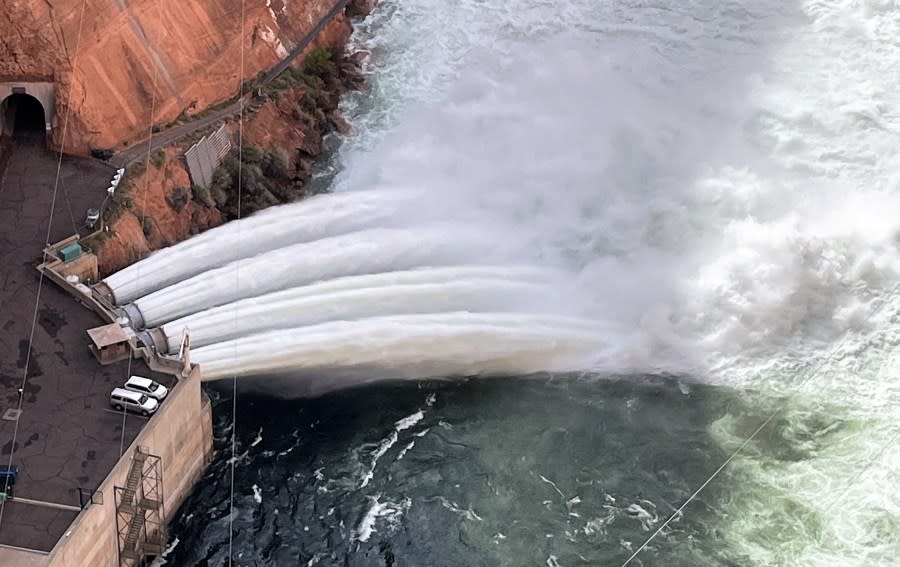New Lake Mead, Lake Powell projections: A breakdown of changes in April’s 24-month study

LAS VEGAS (KLAS) — Projections for Lake Mead show little change after winter snowpack reached 111% of normal levels, but Lake Powell is now expected to go up over the next two years.
The U.S. Bureau of Reclamation’s 24-month study — a forecast updated once a month — shows Lake Mead is projected to drop about 15 feet by the end of July, then climb as high as 1,063.64 feet by February 2025 before dropping to 1,048.24 at the end of July 2025. Those levels closely follow projections issued last month.
That 15-foot drop was anticipated as the hot summer months set in. But changes in the projections show Lake Powell won’t see the same effects, 8½ feet by next summer, a big improvement over projections made just a month ago.
Fluctuations in reservoir levels are normal as seasons change, and spring runoff from the mountains feeds reservoirs all through the system. In recent years, the importance of these fluctuations has grown as a water shortage was declared in August 2022.
Lake Mead was at 1,074.10 feet as of noon on April 15. Lake levels are reported as the elevation of the water’s surface. Lake Powell is at 3,558.25 feet.
Lake Mead is the biggest reservoir in the U.S., storing Colorado River water that’s critical to Nevada, Arizona, California and tribal governments downstream from Hoover Dam. Lake Powell is the second-biggest reservoir. Below are the pages in this month’s 24-month study showing “most probable” levels at both reservoirs over the next two years:
Lake Mead projections as of April 2024:
See the column “Reservoir Elev” second from right:

Lake Powell projections as of April 2024:
See the column “Reservoir Elev” fourth from right.

Just a month ago, Lake Powell was on track to hit its highest level of the year by the end of June, reaching 3,580.86 feet. But that changed in the April projections, which now show Lake Powell hitting 3,587.69 as June ends — a difference of about 7 feet. That translates to a 29-foot increase from spring runoff.
The difference in projections by March 2025 is even greater, with the new report indicating Lake Powell’s lowest level next year will be 3,569.85 feet — about 9 feet higher than projections from last month.
And by June of 2025, Lake Powell will be at 3,599.03 feet — 8½ feet higher than Reclamation’s forecast last month.
Last week, more attention was directed at Lake Powell and problems inside Glen Canyon Dam as reports surfaced that a secondary set of pipes known as the “river outlet works” have been eroding from the inside. Those pipes aren’t used frequently, but if Lake Powell drops drastically they would have to be used to send water downstream to Lake Mead.

A Reclamation report on damage to the pipes advised against relying on those pipes. That follows on a 2022 report publicized by conservationists that the river outlet works couldn’t even carry the volume of water necessary to meet requirements under the Colorado River Compact — the so-called “Law of the River” that for a century has governed how the river is managed as it flows through dams on its way to the Gulf of California.
Changes in the projections this month seem to show Reclamation is continuing to make Lake Powell a priority to guard against the possibility that the reservoir could drop again to critical levels.
This year’s snowpack has already dropped from 111% of normal to closer to 100% just two weeks after the typical “peak” monitoring date of April 1. The blue line on the graph below shows 2024’s snow water equivalent (SWE) compared to the previous 10 years. The light blue dashed line shows the median level over the past 30 years.

Spring snowstorms are important to lifting snow levels beyond the April 1 peak, but they haven’t come yet.
Maps from Reclamation’s website show SWE levels have dropped to 104% of normal (blue box at the center of the map) with a big boost from the Lower San Juan region, which is currently at 257% of normal.

The Colorado Headwaters subregion high up in the Rocky Mountains is the most important of the nine subregions that make up the Upper Colorado River Basin. Snowpack there is the source of the Colorado River. It is currently at 100% of normal.
For the latest news, weather, sports, and streaming video, head to KLAS.

